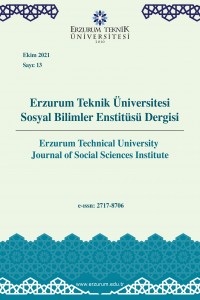Abstract
Dil, karmaşık yapıları düzene koyan biçimsel bir sistemdir. Belirli bir maksadı karşılamak için pek çok yapının bir araya geldiği mantıksal oluşumlar bütünüdür. Dili oluşturan unsurlar, dizisel ve dizimsel eksende mantık ilkeleri çerçevesinde bir araya gelirler. Bir başka deyişle, aralarında hem yapı hem de anlam bakımından bir ahenk söz konusudur. Bu çalışmada, fiil grupları başlığı altında değerlendirilen mastar, partisip ve gerundium grupları daha çok yapısal boyutta ele alınmış, tamlayan ve tamlanan ilişkisi göz önünde bulundurularak, söz dizimi açısından incelenmiştir. Özne, nesne ya da tümleç gibi cümle unsurları, mastar-partisip ve gerundium eklerinden önce fiile bağlanmakta ve fiilden sonra mastar-partisip ve gerundium gruplarının ekleri bağlanarak fiil grupları oluşturulmaktadır. Türkçede sadece isim tamlamalarında tamlayan-tamlanan ilişkisi söz konusu değildir. Aynı zamanda özne-yüklem, nesne-fiil, tümleç–fiil, sıfat-isim, ek-kök arasında da tamlayan ve tamlanan ilişkisi söz konusudur. Üzerinde durduğumuz fiil gruplarında ise, özne/nesne/tümleç-fiil arasında tamlayan-tamlanan ilişkisi söz konusudur. Bundan dolayı fiil grupları, tamlayan ve tamlanan ilişkisi neticesinde değerlendirilmelidir.
References
- Ali, S. (2018). İçimizdeki Şeytan. İstanbul: Yapı Kredi Yayınları.
- Ali, S. (2019). Kürk Mantolu Madonna. İstanbul: Yapı Kredi Yayınları.
- Ali, S. (2019). Kuyucaklı Yusuf. İstanbul: Yapı Kredi Yayınları.
- Banguoğlu, T. (2015). Türkçenin Grameri. Ankara: TDK Yayınları.
- Baş, E. (2019). Türkiye Türkçesinde Söz Dizimi. Türkiyat Mecmuası, (29) 2, 669-672.
- Başkan, Ö. (2006). Dilde Yaratıcılık. İstanbul: Multilingual Yayınları.
- Çelik, Z. (2020). Türkiye Türkçesinde Söz Dizimi. Çukurova Üniversitesi Türkoloji Araştırmaları Dergisi, (5) 1, 229-232.
- Daşdemir, M. (2014). Oklama Yöntemiyle Türkçenin Yapısal-İşlevsel Söz Dizimi. Erzurum: Eser Basım Yayınları.
- Dostoyevski, F.M. (2019). Ev Sahibesi. İstanbul: Türkiye İş Bankası Kültür Yayınları.
- Ergin, M. (2019). Edebiyat ve Eğitim Fakültelerinin Türk Dili ve Edebiyatı Bölümleri İçin Türk Dil Bilgisi. İstanbul: Boğaziçi Yayınları.
- Gemalmaz, E. (1982). Derin Yapı (Deep Structure) İlişkilerinin Gösteriminde Kullanılacak Bir Yöntem: “Oklama”. Atatürk Üniversitesi Türkiyat Araştırmaları Enstitüsü Dergisi, 3.
- Gencan, T.N. (1971). Dilbilgisi. Ankara: TDK Yayınları.
- Guzev, V. (2007). Söz Dizimi Birimleri Üzerine. Türk Dili Araştırmaları Yıllığı-Belleten, 56 (2), 43-46.
- Karaağaç, G. (2013). Dil Bilimi Terimleri Sözlüğü. Ankara: TDK Yayınları.
- Karahan, L. (1998). Türkçede Söz Dizimi –Cümle Tahlilleri-. Ankara: Akçağ Yayınları.
- Küçük, S. (2009). Türkçenin Söz Dizimi. Türklük Bilimi Araştırmaları, 28, 429-432.
- Korkmaz, Z. (1992). Gramer Terimler Sözlüğü. Ankara: TDK Yayınları.
- Özkan, M. (2013). Yüksek Öğretimde Türk Dili Yazılı ve Sözlü Anlatım. İstanbul: Filiz Kitapevi Yayınları.
- Rauf, M. (2014). Eylül. Ankara: Akçağ Yayınları.
- Tanyıldızı, F. (2020). Türkiye Türkçesinin Söz Dizimi. Siirt Üniversitesi Sosyal Bilimler Enstitüsü Dergisi, (16), 481-485.
- Tolstoy, K.N. (2019). İnsan Neyle Yaşar?. (Çev: Koray Karasulu). İstanbul: Türkiye İş Bankası Kültür Yayınları.
- Uygun, M. (2015). Türkiye Türkçesi Söz Dizimi. Selçuk Üniversitesi Edebiyat Fakültesi Dergisi, 0 ( 36), 607-610.
- Vardar, B. (2001). Dilbilim Yazıları. İstanbul: Multilingual Yayınları.
- (http://www.tdk.gov.tr) (Erişim Tarihi: 07.05.2021, 14.05).
Abstract
Language is a formal system which sequences complex structures. It is the whole of logical formations where many structures come together to realize a specific objective. The elements which comprise a language are clustered within a sequential and syntagmatic plane and according to the principles of logic. In other words, these clusters come together in a harmony in terms of structure and meaning. This study focuses on the structural aspects of verb groups, namely infinitive, participle and gerundium, and analyzes the sequential properties of these groups through the relationship between determinant and determinatum. Sentence elements such as subject, object or complement connect to the verb before the suffixes of infinitive, participle and gerundium, and the suffixes of infinitive, participle and gerundium are added to the verb to form verb groups. The relationship between determinant and determinatum does not only manifest in possessive constructions in Turkish; it manifests between subject and object, complement and verb, adjective and noun, and suffix and stem. The verb groups which this study focuses on manifest a determinant-determinatum relationship between subject/object/complement and verb. Hence verb groups must be evaluated based on the result of the relationship between determinant and determinatum.
References
- Ali, S. (2018). İçimizdeki Şeytan. İstanbul: Yapı Kredi Yayınları.
- Ali, S. (2019). Kürk Mantolu Madonna. İstanbul: Yapı Kredi Yayınları.
- Ali, S. (2019). Kuyucaklı Yusuf. İstanbul: Yapı Kredi Yayınları.
- Banguoğlu, T. (2015). Türkçenin Grameri. Ankara: TDK Yayınları.
- Baş, E. (2019). Türkiye Türkçesinde Söz Dizimi. Türkiyat Mecmuası, (29) 2, 669-672.
- Başkan, Ö. (2006). Dilde Yaratıcılık. İstanbul: Multilingual Yayınları.
- Çelik, Z. (2020). Türkiye Türkçesinde Söz Dizimi. Çukurova Üniversitesi Türkoloji Araştırmaları Dergisi, (5) 1, 229-232.
- Daşdemir, M. (2014). Oklama Yöntemiyle Türkçenin Yapısal-İşlevsel Söz Dizimi. Erzurum: Eser Basım Yayınları.
- Dostoyevski, F.M. (2019). Ev Sahibesi. İstanbul: Türkiye İş Bankası Kültür Yayınları.
- Ergin, M. (2019). Edebiyat ve Eğitim Fakültelerinin Türk Dili ve Edebiyatı Bölümleri İçin Türk Dil Bilgisi. İstanbul: Boğaziçi Yayınları.
- Gemalmaz, E. (1982). Derin Yapı (Deep Structure) İlişkilerinin Gösteriminde Kullanılacak Bir Yöntem: “Oklama”. Atatürk Üniversitesi Türkiyat Araştırmaları Enstitüsü Dergisi, 3.
- Gencan, T.N. (1971). Dilbilgisi. Ankara: TDK Yayınları.
- Guzev, V. (2007). Söz Dizimi Birimleri Üzerine. Türk Dili Araştırmaları Yıllığı-Belleten, 56 (2), 43-46.
- Karaağaç, G. (2013). Dil Bilimi Terimleri Sözlüğü. Ankara: TDK Yayınları.
- Karahan, L. (1998). Türkçede Söz Dizimi –Cümle Tahlilleri-. Ankara: Akçağ Yayınları.
- Küçük, S. (2009). Türkçenin Söz Dizimi. Türklük Bilimi Araştırmaları, 28, 429-432.
- Korkmaz, Z. (1992). Gramer Terimler Sözlüğü. Ankara: TDK Yayınları.
- Özkan, M. (2013). Yüksek Öğretimde Türk Dili Yazılı ve Sözlü Anlatım. İstanbul: Filiz Kitapevi Yayınları.
- Rauf, M. (2014). Eylül. Ankara: Akçağ Yayınları.
- Tanyıldızı, F. (2020). Türkiye Türkçesinin Söz Dizimi. Siirt Üniversitesi Sosyal Bilimler Enstitüsü Dergisi, (16), 481-485.
- Tolstoy, K.N. (2019). İnsan Neyle Yaşar?. (Çev: Koray Karasulu). İstanbul: Türkiye İş Bankası Kültür Yayınları.
- Uygun, M. (2015). Türkiye Türkçesi Söz Dizimi. Selçuk Üniversitesi Edebiyat Fakültesi Dergisi, 0 ( 36), 607-610.
- Vardar, B. (2001). Dilbilim Yazıları. İstanbul: Multilingual Yayınları.
- (http://www.tdk.gov.tr) (Erişim Tarihi: 07.05.2021, 14.05).
Details
| Primary Language | Turkish |
|---|---|
| Subjects | Linguistics |
| Journal Section | Research Article |
| Authors | |
| Publication Date | October 31, 2021 |
| Published in Issue | Year 2021 Issue: 13 |



